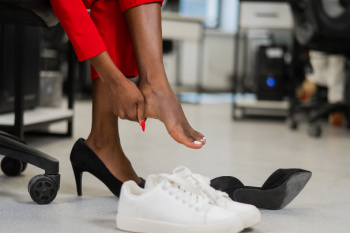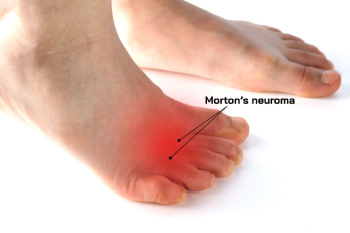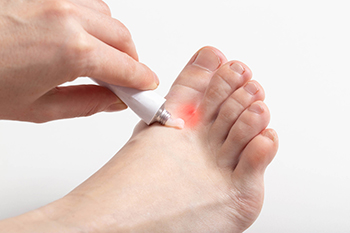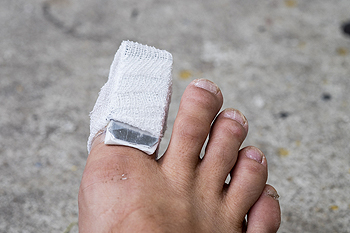August 2024
Possible Causes and Treatments of Plantar Fasciitis

The plantar fascia is a long, thick band of tissue that spans from the heel bone along the bottom of the foot to the toes. The plantar fascia supports the bottom of the feet and toes during walking, running, and jumping. It can become overly stressed, or even tear or rupture, from overuse or injury that causes pain and inflammation, termed plantar fasciitis. Being obese, standing or working on your feet for prolonged periods of time, or having flat feet or high arches can all contribute to this condition. Engaging in activities that involve dancing, marching, or running can also add to, or possibly worsen, the symptoms of plantar fasciitis. Certain footwear, such as high heels, flip flops, worn out shoes, or other types of footwear with inadequate support, can also increase the risk of developing this condition. A podiatrist will use a variety of ways to treat plantar fasciitis depending upon the severity of the condition and how long the patient has been suffering from it. If you have been dealing with pain from plantar fasciitis, it is suggested you schedule an appointment with a podiatrist for a diagnosis and comprehensive treatment plan.
Plantar fasciitis can be very painful and inconvenient. If you are experiencing heel pain or symptoms of plantar fasciitis, contact one of our doctors from Coral Desert Foot & Ankle. Our doctors can provide the care you need to keep you pain-free and on your feet.
What Is Plantar Fasciitis?
Plantar fasciitis is the inflammation of the thick band of tissue that runs along the bottom of your foot, known as the plantar fascia, and causes mild to severe heel pain.
What Causes Plantar Fasciitis?
- Excessive running
- Non-supportive shoes
- Overpronation
- Repeated stretching and tearing of the plantar fascia
How Can It Be Treated?
- Conservative measures – anti-inflammatories, ice packs, stretching exercises, physical therapy, orthotic devices
- Shockwave therapy – sound waves are sent to the affected area to facilitate healing and are usually used for chronic cases of plantar fasciitis
- Surgery – usually only used as a last resort when all else fails. The plantar fascia can be surgically detached from the heel
While very treatable, plantar fasciitis is definitely not something that should be ignored. Especially in severe cases, speaking to your doctor right away is highly recommended to avoid complications and severe heel pain. Your podiatrist can work with you to provide the appropriate treatment options tailored to your condition.
If you have any questions please feel free to contact one of our offices located in St. George and Kanab, UT, and Mesquite, NV . We offer the newest diagnostic and treatment technologies for all your foot and ankle needs.
What Is Morton’s Neuroma?

Morton's neuroma is a painful condition affecting the ball of the foot, typically between the third and fourth toes. It involves the thickening of tissue surrounding one of the nerves leading to the toes, causing sharp, burning pain, numbness, or a sensation of something being lodged in the foot. To diagnose Morton's neuroma, a podiatrist will perform a physical examination, checking for tenderness and a palpable mass between the toes. Imaging tests like ultrasound or MRI scans may be used for confirmation. Treatment options include modifying footwear to reduce pressure on the affected area, using orthotic inserts, and administering corticosteroid injections to reduce inflammation. In severe cases, surgical removal of the affected nerve may be necessary to alleviate symptoms and restore normal foot function. If you have pain in the ball of your foot, it is suggested that you schedule an appointment with a podiatrist for a proper diagnosis and treatment plan.
Morton’s neuroma is a very uncomfortable condition to live with. If you think you have Morton’s neuroma, contact one of our doctors of Coral Desert Foot & Ankle. Our doctors will attend to all of your foot care needs and answer any of your related questions.
Morton’s Neuroma
Morton's neuroma is a painful foot condition that commonly affects the areas between the second and third or third and fourth toe, although other areas of the foot are also susceptible. Morton’s neuroma is caused by an inflamed nerve in the foot that is being squeezed and aggravated by surrounding bones.
What Increases the Chances of Having Morton’s Neuroma?
- Ill-fitting high heels or shoes that add pressure to the toe or foot
- Jogging, running or any sport that involves constant impact to the foot
- Flat feet, bunions, and any other foot deformities
Morton’s neuroma is a very treatable condition. Orthotics and shoe inserts can often be used to alleviate the pain on the forefront of the feet. In more severe cases, corticosteroids can also be prescribed. In order to figure out the best treatment for your neuroma, it’s recommended to seek the care of a podiatrist who can diagnose your condition and provide different treatment options.
If you have any questions, please feel free to contact one of our offices located in St. George and Kanab, UT, and Mesquite, NV . We offer the newest diagnostic and treatment technologies for all your foot care needs.
Treating Athlete’s Foot
 Athlete's foot, or tinea pedis, is a common fungal infection that affects the skin of the feet. It is caused by dermatophytes, fungi thriving in warm, moist environments like shoes, locker rooms, and swimming pools. Symptoms can include itching, stinging, and burning between the toes or on the soles, in addition to blisters, cracking, peeling, and dry skin. Risk factors include walking barefoot in communal areas, sharing footwear, having sweaty feet, and wearing tight-fitting shoes. People with weakened immune systems or diabetes are particularly susceptible. Treatment involves antifungal medications, available as creams, sprays, powders, or oral medications. Keeping feet clean and dry, changing socks regularly, and using antifungal powders can prevent recurrence. Complications can arise if left untreated, such as secondary bacterial infections, spreading to other body parts, and chronic infection. If you have a severe case of athlete’s foot, it is suggested that you visit a podiatrist for more aggressive treatment and medical supervision.
Athlete's foot, or tinea pedis, is a common fungal infection that affects the skin of the feet. It is caused by dermatophytes, fungi thriving in warm, moist environments like shoes, locker rooms, and swimming pools. Symptoms can include itching, stinging, and burning between the toes or on the soles, in addition to blisters, cracking, peeling, and dry skin. Risk factors include walking barefoot in communal areas, sharing footwear, having sweaty feet, and wearing tight-fitting shoes. People with weakened immune systems or diabetes are particularly susceptible. Treatment involves antifungal medications, available as creams, sprays, powders, or oral medications. Keeping feet clean and dry, changing socks regularly, and using antifungal powders can prevent recurrence. Complications can arise if left untreated, such as secondary bacterial infections, spreading to other body parts, and chronic infection. If you have a severe case of athlete’s foot, it is suggested that you visit a podiatrist for more aggressive treatment and medical supervision.
Athlete’s Foot
Athlete’s foot is often an uncomfortable condition to experience. Thankfully, podiatrists specialize in treating athlete’s foot and offer the best treatment options. If you have any questions about athlete’s foot, consult with one of our doctors from Coral Desert Foot & Ankle. Our doctors will assess your condition and provide you with quality treatment.
What Is Athlete’s Foot?
Tinea pedis, more commonly known as athlete’s foot, is a non-serious and common fungal infection of the foot. Athlete’s foot is contagious and can be contracted by touching someone who has it or infected surfaces. The most common places contaminated by it are public showers, locker rooms, and swimming pools. Once contracted, it grows on feet that are left inside moist, dark, and warm shoes and socks.
Prevention
The most effective ways to prevent athlete’s foot include:
- Thoroughly washing and drying feet
- Avoid going barefoot in locker rooms and public showers
- Using shower shoes in public showers
- Wearing socks that allow the feet to breathe
- Changing socks and shoes frequently if you sweat a lot
Symptoms
Athlete’s foot initially occurs as a rash between the toes. However, if left undiagnosed, it can spread to the sides and bottom of the feet, toenails, and if touched by hand, the hands themselves. Symptoms include:
- Redness
- Burning
- Itching
- Scaly and peeling skin
Diagnosis and Treatment
Diagnosis is quick and easy. Skin samples will be taken and either viewed under a microscope or sent to a lab for testing. Sometimes, a podiatrist can diagnose it based on simply looking at it. Once confirmed, treatment options include oral and topical antifungal medications.
If you have any questions, please feel free to contact one of our offices located in St. George and Kanab, UT, and Mesquite, NV . We offer the newest diagnostic and treatment technologies for all your foot care needs.
Complications of a Broken Toe

A broken toe might seem like a minor injury, but it can lead to significant complications if not properly treated. Untreated fractures can result in persistent pain, deformities, reduced mobility, and long-term difficulties in walking. Fractures that affect the big toe can lead to deformities and a restricted range of motion. Toe fractures that involve joint cartilage can cause traumatic osteoarthritis and further joint deformities. Surgery, although sometimes necessary, carries risks such as nerve damage and infection. Seeing a podiatrist promptly after a toe injury ensures that the fracture is correctly diagnosed and appropriately managed. A podiatrist can provide such treatment as casting or buddy taping, to keep the injured toe straight and immobilized while healing. Treatment for a broken toe typically involves a cast or tape to keep the toe straight and promote healing. Depending on the toe and the severity of the injury, it may take up to eight weeks for the fracture to heal. If you have broken a toe, it is suggested that you schedule an appointment with a podiatrist for an exam, diagnosis, and treatment options.
Broken toes may cause a lot of pain and should be treated as soon as possible. If you have any concerns about your feet, contact one of our doctors from Coral Desert Foot & Ankle. Our doctors will treat your foot and ankle needs.
What Is a Broken Toe?
A broken toe occurs when one or more of the toe bones of the foot are broken after an injury. Injuries such as stubbing your toe or dropping a heavy object on it may cause a toe fracture.
Symptoms of a Broken Toe
- Swelling
- Pain (with/without wearing shoes)
- Stiffness
- Nail Injury
Although the injured toe should be monitored daily, it is especially important to have a podiatrist look at your toe if you have severe symptoms. Some of these symptoms include worsening or new pain that is not relieved with medication, sores, redness, or open wounds near the toe.
If you have any questions, please feel free to contact one of our offices located in St. George and Kanab, UT, and Mesquite, NV . We offer the newest diagnostic and treatment technologies for all your foot care needs.





